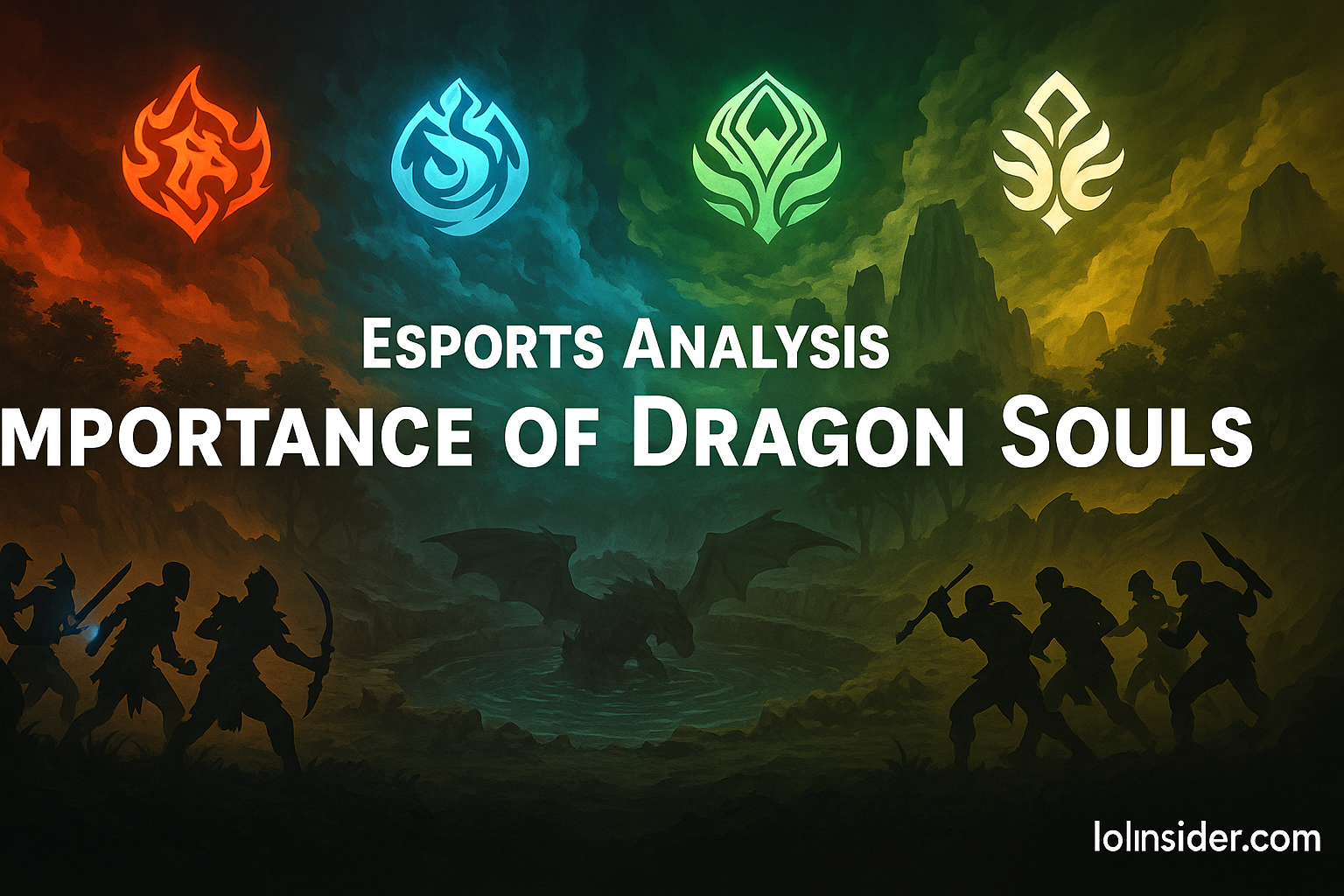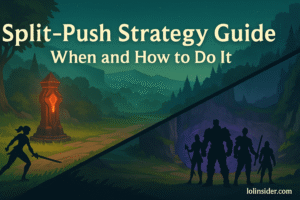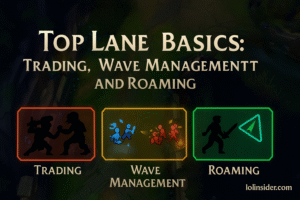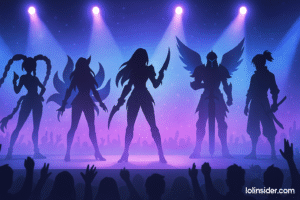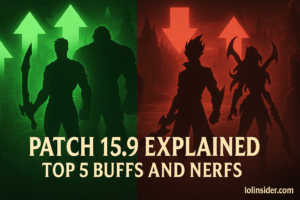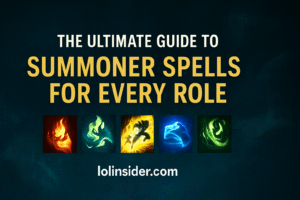Few objectives in League of Legends have as much impact on professional matches as Dragon Souls. While Baron Nashor often steals the spotlight, the reality is that Dragon Souls frequently decide games before Baron ever spawns. For pros, analysts, and fans alike, understanding their importance is key to appreciating the depth of esports strategy.
In this Esports Analysis: Importance of Dragon Souls, we’ll explore why these objectives matter so much, how each soul shapes pro play, and why controlling the bottom side of the map often means controlling victory.
1. The Evolution of Dragon in Esports
Back in Season 3, dragon offered only global gold. It was important but far from game-ending. With the introduction of elemental dragons in Season 6, everything changed.
- Elemental Variety: Infernal, Mountain, Cloud, Ocean.
- Stacking Mechanics: Buffs build per drake taken.
- Dragon Soul: At four dragons, the permanent buff defines late game.
The shift transformed dragons from “secondary objective” to primary win condition in esports.
2. Why Dragon Souls Are So Important
Permanent Buff
Unlike Baron or Rift Herald, Dragon Souls never expire. Once secured, they last the entire game.
Teamfight Power
Dragon Souls amplify strengths:
- Infernal → damage boost.
- Ocean → sustain.
- Mountain → defense.
- Cloud → mobility.
Win Condition
At pro level, securing soul often forces enemies into desperate fights, even when behind.
Map Pressure
Teams must contest bottom side objectives earlier, influencing vision and rotations.
3. Esports Data: Dragon Soul Win Rates
Across professional leagues (LCK, LPL, LEC, LCS):
- Teams securing Dragon Soul win ~85% of games.
- Some souls (Infernal, Ocean) push win rates even higher.
- First two drakes often dictate whether a team can threaten Soul.
Simply put: Dragon Souls decide games before Elder or Baron in most pro matches.
4. The Four Dragon Souls in Esports
Infernal Soul
- Extra AoE true damage on autos/abilities.
- Best in teamfights, shredding squishy backlines.
- Teams often draft poke/long-range comps with this in mind.
Ocean Soul
- Restores HP during combat.
- Dominates extended fights and siege scenarios.
- Prioritized heavily in slower scaling metas.
Mountain Soul
- Grants a scaling shield.
- Best against burst compositions.
- Perfect for front-to-back pro teamfights.
Cloud Soul
- Ult cooldown reduction and movement speed.
- Situational but extremely strong on engage comps (Malphite, Hecarim, Sejuani).
5. How Dragon Souls Shape Pro Drafts
- Scaling Teams: Draft around Ocean/Mountain for durability.
- Poke Comps: Thrive with Infernal for burn damage.
- Engage Comps: Favor Cloud Soul to initiate repeatedly.
In esports, coaches adjust draft priorities depending on which soul is possible.
6. Dragon vs Baron: Which Matters More?
- Baron Nashor: Provides short-term siege power.
- Dragon Soul: Provides permanent scaling advantage.
In pro play, Dragon Soul is often prioritized before Baron unless the game state forces a trade. Many analysts argue that Dragon Soul > Baron in most situations.
7. Case Studies from Pro Play
LCK 2022 Finals – T1 vs Gen.G
- T1 secured Ocean Soul, enabling Faker’s Azir to out-sustain teamfights.
- Despite Gen.G’s gold lead, the soul turned fights around.
Worlds 2021 – EDG vs DWG KIA
- Mountain Soul allowed EDG to absorb Canyon’s engages.
- This defensive edge carried them to a 3–2 championship victory.
MSI 2019 – G2 Esports vs SKT
- Early dragon stacking gave G2 win conditions before SKT could scale.
- Soul control forced SKT into unfavorable fights.
8. The Strategic Importance of Bot Lane
Because dragons spawn bottom side, bot lane is more than just an ADC vs ADC duel. It’s the anchor of pro strategy.
- Supports roam for early drake priority.
- ADCs play safer to secure dragon control.
- Junglers path bot side to align with spawn timers.
Pro teams that dominate bot lane often dominate dragon setups.
9. Vision and Objective Control
Dragon fights are not just about damage — they’re about vision. Pro teams:
- Use Control Wards around dragon pit.
- Contest river plants and scuttle.
- Deny enemy jungle entrances with pinks.
Vision denial ensures first engage, often deciding dragon fights before they even start.
10. Elder Dragon and Soul Interaction
After one team secures Dragon Soul, the Elder Dragon becomes the next evolution:
- Provides true damage execute.
- Stacks with Soul, making a team virtually unstoppable.
- Pro matches rarely continue long after Elder + Soul is secured.
11. The Psychology of Dragon Souls
Dragon Souls aren’t just numbers. They pressure the enemy team mentally:
- Teams feel forced to contest, even when behind.
- Losing Soul often breaks morale in pro play.
- Fans and casters call Soul “the point of no return.”
12. How to Translate Esports Lessons to Solo Queue
- Track timers: Ping dragon spawns at 1:30.
- Prioritize vision: Always ward river entrances before spawn.
- Communicate fights: Don’t coin-flip 50/50 smites without setup.
- Play for scaling: Souls often win games more than Baron pushes.
Even in solo queue, controlling drakes increases win rate dramatically.
Conclusion
This Esports Analysis: Importance of Dragon Souls proves that they are more than just objectives — they are win conditions. For professional teams, controlling dragon stacking defines drafts, rotations, and late-game victories.
From Infernal’s burst to Ocean’s sustain, Mountain’s shield to Cloud’s engage power, Dragon Souls are the permanent buffs that tilt the balance of pro matches. If you want to understand modern esports or improve your own climb, start by respecting the dragon.
Because in today’s League, the team that controls Dragon Souls often controls the Fate of the Rift.

